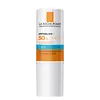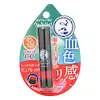What's inside
What's inside
 Key Ingredients
Key Ingredients

 Benefits
Benefits

 Concerns
Concerns

 Ingredients Side-by-side
Ingredients Side-by-side

Ricinus Communis Seed Oil
MaskingIsopropyl Palmitate
EmollientPolyethylene
AbrasiveOctocrylene
UV AbsorberIsohexadecane
EmollientTitanium Dioxide
Cosmetic ColorantOzokerite
Emulsion StabilisingButyl Methoxydibenzoylmethane
UV AbsorberDrometrizole Trisiloxane
UV AbsorberTheobroma Cacao Seed Butter
EmollientButyrospermum Parkii Butter
Skin ConditioningWater
Skin ConditioningDimethicone
EmollientGlycine Soja Oil
EmollientSilica
AbrasiveTocopherol
AntioxidantCetyl Ethylhexanoate
EmollientPolyethylene
AbrasiveDiisostearyl Malate
EmollientC10-30 Cholesterol/Lanosterol Esters
EmulsifyingEthylhexyl Methoxycinnamate
UV AbsorberLanolin
EmollientPetrolatum
EmollientMicrocrystalline Wax
Emulsion StabilisingWater
Skin ConditioningSimmondsia Chinensis Seed Oil
EmollientOlea Europaea Fruit Oil
MaskingTocopherol
AntioxidantTocopheryl Acetate
AntioxidantTetrahexyldecyl Ascorbate
Antioxidant1,2-Hexanediol
Skin ConditioningButyl Methoxydibenzoylmethane
UV AbsorberPolyglyceryl-4 Oleate
EmulsifyingPolyglyceryl-2 Triisostearate
EmulsifyingHydrogen Dimethicone
Polyglyceryl-6 Polyricinoleate
EmulsifyingBarium Sulfate
Cosmetic ColorantSynthetic Fluorphlogopite
Titanium Dioxide
Cosmetic ColorantCI 15985
Cosmetic ColorantCI 45380
Cosmetic ColorantCetyl Ethylhexanoate, Polyethylene, Diisostearyl Malate, C10-30 Cholesterol/Lanosterol Esters, Ethylhexyl Methoxycinnamate, Lanolin, Petrolatum, Microcrystalline Wax, Water, Simmondsia Chinensis Seed Oil, Olea Europaea Fruit Oil, Tocopherol, Tocopheryl Acetate, Tetrahexyldecyl Ascorbate, 1,2-Hexanediol, Butyl Methoxydibenzoylmethane, Polyglyceryl-4 Oleate, Polyglyceryl-2 Triisostearate, Hydrogen Dimethicone, Polyglyceryl-6 Polyricinoleate, Barium Sulfate, Synthetic Fluorphlogopite, Titanium Dioxide, CI 15985, CI 45380
Ingredients Explained
These ingredients are found in both products.
Ingredients higher up in an ingredient list are typically present in a larger amount.
Also known as Avobenzone, this ingredient is a chemical sunscreen filter that provides protection in the UV-A range.
Avobenzone is globally approved and is the most commonly used UV-A filter in the world.
Studies have found that avobenzone becomes ineffective when exposed to UV light (it is not photostable; meaning that it breaks down in sunlight). Because of this, formulations that include avobenzone will usually contain stabilizers such as octocrylene.
However, some modern formulations (looking at you, EU!) are able to stabilize avobenzone by coating the molecules.
Avobenzone does not protect against the UV-B range, so it's important to check that the sunscreen you're using contains other UV filters that do!
The highest concentration of avobenzone permitted is 3% in the US, and 5% in the EU.
Learn more about Butyl MethoxydibenzoylmethanePolyethylene is a synthetic ingredient that helps the skin retain moisture. It is a polymer.
It is also typically used within product formulations to help bind solid ingredients together and thicken oil-based ingredients. When added to balms and emulsions, it helps increase the melting point temperature.
Titanium dioxide is a mineral UV filter widely used in sunscreens and cosmetics.
It is one of only two UV filters officially classified as “mineral” by regulatory agencies, the other being zinc oxide.
Titanium dioxide provides broad-spectrum protection mostly in the UVB and UVAII range, with some protection in the UVAI range.
While its UVA protection isn’t as strong as zinc oxide’s, the difference is minor.
A common myth is that mineral UV filters reflect UV light. However, modern research shows titanium dioxide absorbs UV radiation like chemical filters (~95% absorption & 5% reflection).
Thanks to its non-irritating nature, titanium dioxide is suitable for sensitive, acne-prone, or redness-prone skin. It is unlikely to cause "eye sting" like other sunscreen ingredients.
A major drawback of this ingredient is its white cast and thick texture. This is why mineral sunscreens often leave a white cast and are less cosmetically elegant than chemical/hybrid sunscreens.
To improve white cast and spreadability, micronized or nano-sized titanium dioxide is often used.
There are ongoing concerns surrounding nano-titanium oxide's impact on marine ecosystems.
There is no conclusive evidence that any form of titanium oxide (or any other sunscreen ingredients) will cause harm to marine ecosystems or coral reefs. The science is still developing but many consumers are keeping a close eye on this issue.
Please note, many destinations have reef-safety sunscreen rules. For instance, the U.S. Virgin Islands advises all visitors to use non-nano mineral sunscreens.
Nano mineral sunscreens once raised safety concerns about absorption into skin.
Extensive research has shown that they do not penetrate healthy or damaged skin; they remain safely on the surface and the top layer of dead skin (stratum corneum).
You'll likely find titanium dioxide bundled with alumina, silica, or dimethicone. These ingredients help make titanium dioxide highly photostable; this prevents it from interacting with other formula components under UV light.
Learn more about Titanium DioxideTocopherol (also known as Vitamin E) is a common antioxidant used to help protect the skin from free-radicals and strengthen the skin barrier. It's also fat soluble - this means our skin is great at absorbing it.
Vitamin E also helps keep your natural skin lipids healthy. Your lipid skin barrier naturally consists of lipids, ceramides, and fatty acids. Vitamin E offers extra protection for your skin’s lipid barrier, keeping your skin healthy and nourished.
Another benefit is a bit of UV protection. Vitamin E helps reduce the damage caused by UVB rays. (It should not replace your sunscreen). Combining it with Vitamin C can decrease sunburned cells and hyperpigmentation after UV exposure.
You might have noticed Vitamin E + C often paired together. This is because it is great at stabilizing Vitamin C. Using the two together helps increase the effectiveness of both ingredients.
There are often claims that Vitamin E can reduce/prevent scarring, but these claims haven't been confirmed by scientific research.
Learn more about TocopherolWater. It's the most common cosmetic ingredient of all. You'll usually see it at the top of ingredient lists, meaning that it makes up the largest part of the product.
So why is it so popular? Water most often acts as a solvent - this means that it helps dissolve other ingredients into the formulation.
You'll also recognize water as that liquid we all need to stay alive. If you see this, drink a glass of water. Stay hydrated!
Learn more about Water